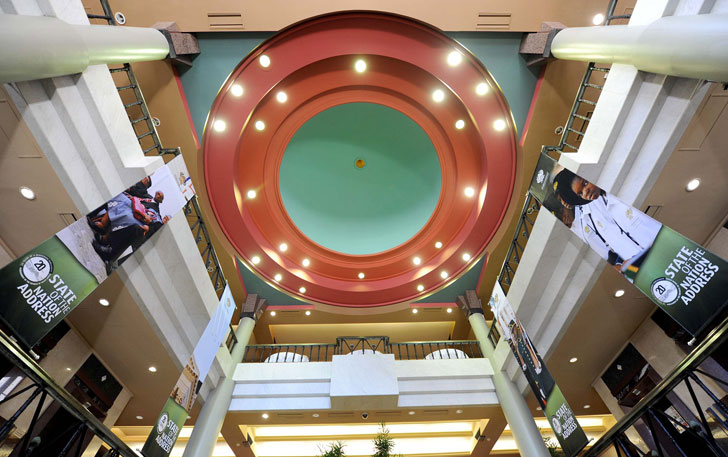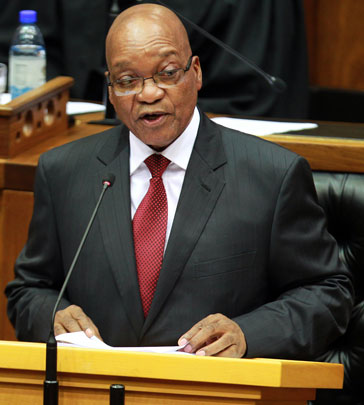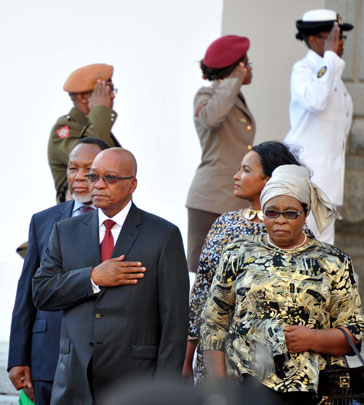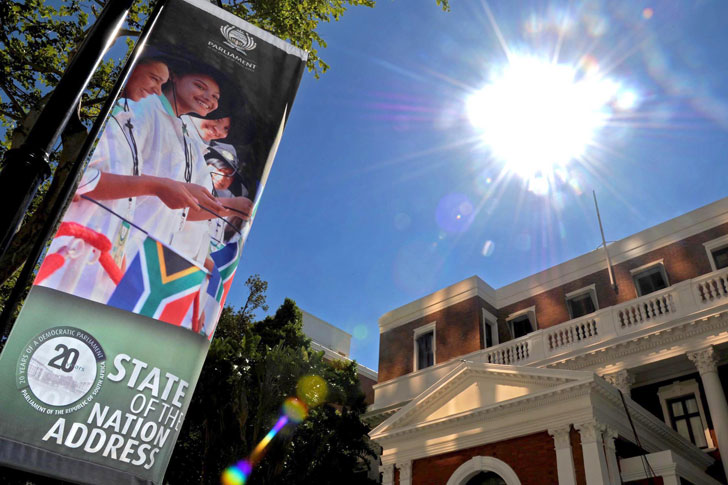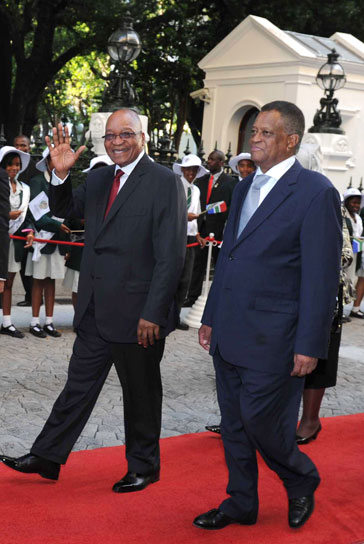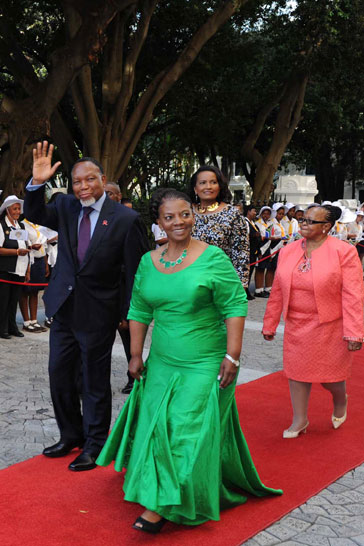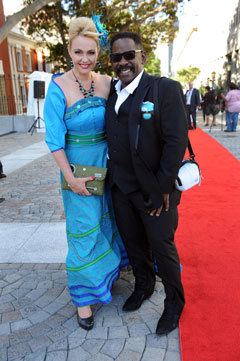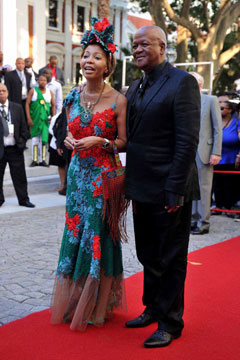| |
|
| |
STATE OF THE NATION ADDRESS 2014:
“WE HAVE A GOOD STORY TO TELL” |
| |
|
| |
| President Jacob Zuma reported at length on progress in the country's infrastructure programme since 2009. |
| |
|
| |
President Jacob Zuma used his sixth State of the Nation Address (SONA) on Thursday, 13 February 2014, to highlight South Africa's achievements over the past five years, while acknowledging that more needs to be done to tackle growing youth unemployment.
Among the completed projects he highlighted were the Rea Vaya bus rapid transit system in Johannesburg, which is now used by more than 100 000 people a month, with similar systems under construction in Cape Town, Pretoria, Port Elizabeth, East London, Durban and Rustenburg.
The country's harbours and ports have been improved, 1 500 kilometres of new roads and road lanes have been built countrywide, construction of new rail lines is underway in Mpumalanga, and a 700-kilometre fuel pipeline has been built between Durban to Gauteng to transport four-billion cubic litres of petrol, diesel and jet fuel a year.
The Gautrain rapid rail link between Johannesburg, Pretoria and OR Tambo International Airport carries over 1,2 million passengers a month, and the Passenger Rail Agency of South Africa will spend over R120 billion over the next 10 years on buying new trains and further improving the country's transport system.
Transnet, meanwhile, will be spending R300 billion on transport infrastructure under its market demand strategy, which it has begun implementing.
To realise the economic potential of the Western Cape and the West Coast, the Government had launched the Saldanha Bay Industrial Development Zone and opened two new factories in Atlantis outside Cape Town.
To improve the water supply, two large new dams, the De Hoop Dam in Limpopo and the Spring Grove Dam in KwaZulu-Natal, had been completed, while phase two of the Lesotho Highlands Water Project was expected to be launched soon.
Construction was also continuing on the country's new power stations, Medupi in Limpopo, Kusile in Mpumalanga and Ingula near Ladysmith, together employing more than 30 000 workers.
"We continue to explore other sources of energy, in line with the Integrated Resource Plan for Energy," President Zuma said. "The development of petroleum, especially shale gas, will be a game-changer for the Karoo region and the South African economy."
He said that on average the economy had grown at 3,2% a year from 1994 to 2012, despite a global recession which had cost the country a million jobs.
South Africa's national wealth, measured in terms of gross domestic product (GDP), had grown to more than R3,5 trillion. There were now 15 million South Africans with jobs, the highest in the country's history, with over 650 000 jobs created in 2013.
"This is still not good enough," President Zuma said. "The unemployment rate still remains high. Youth unemployment in South Africa continues to be of concern, as it is throughout the world."
The Government would have to work together with business and labour to grow the economy at rates above 5% to be able to create the jobs the country needed.
South Africa continued to face the triple challenge of poverty, inequality and unemployment, the President said, and tackling these challenges had become a central focus of all democratic administrations.
Zuma said the National Development Plan (NDP) was a viable plan for driving South Africa's socio-economic development, eliminating poverty and reducing inequality by 2030.
According to the NDP, South Africa can realise these goals by drawing on the energies of its people, growing an inclusive economy, building capabilities, enhancing the capacity of the State, and promoting leadership and partnerships throughout society. – Source: www.SAnews.gov.za |
|
| |
|
| |
| ON INTERNATIONAL RELATIONS … |
| |
|
|
| |
| “Africa has remained at the centre of our foreign policy.” |
| |
Addressing the nation, President Jacob Zuma said that democratic South Africa’s foreign policy was shaped many decades ago during the fierce international campaign to isolate the apartheid state.
He referred to African National Congress President, Oliver Tambo, and said he played a key role in that regard, assisted by among others, the late Jonny Makhatini, former head of international affairs.
“We have worked hard to strengthen support for the African Union, SADC and all continental bodies whose purpose is to achieve peace and security.
“We have also prioritised the promotion of regional economic integration, infrastructure development, intra-African trade and sustainable development in the continent.
“This year we also submitted our third country report to the AU African Peer Review Mechanism which was well received.
“We continue to support peace-making and conflict resolution.
“Progress is being made in negotiations between Sudan and South Sudan on outstanding issues following the secession.
“Following requests from Sri Lanka and South Sudan for assistance in bringing about peace and reconciliation, Mr Cyril Ramaphosa, has been appointed as South Africa’s Special Envoy to the two countries."
President Zuma said that South Africa would continue to strengthen relations with Europe, North America, Latin America, Asia and countries in the South and that participation in international multilateral forums such as the G20 have been beneficial for the country.
“And joining the Brazil, Russia, India and China (BRIC) group in December 2010 counts as among the key achievements of the fourth administration. It was also a great honour to host the Fifth BRICS Summit on 27 March 2013 in Durban, which saw the participation of African leaders to discuss developmental cooperation with BRICS."
He said that South Africa would continue to serve diligently in the United Nations (UN) in promotion of strong international governance and that the country would continue promoting the reform of the UN Security Council and global financial institutions.
Referring to the COP17/CMP7 UN Climate Change conference which was hosted in Durban in 2011, the President said that South Africa successfully placed the world on an unassailable course, through the adoption of the Durban Platform for Enhanced Action. |
|
| |
|
| |
| SONA IN NUMBERS |
| |
|
|
| |
| Growing the economy and creating jobs |
| |
• 3,2% – average annual economic growth from 1994 to 2012
• The national wealth, measured in gross domestic product, has grown to more than R3,5 trillion
• 15 million – the number of people with jobs
• Some 650 000 jobs were created in 2013
• 3,7 million – work opportunities created since 2009
• 6 million – the number of work opportunities expected between 2014 and 2019 for youth in particular
• 16 million – the number of citizens on social assistance
• 17,3% – decline in the value of the rand against the US dollar in 2013
• Under 300 days – the time it will take to start a mine from application to final approval
• R20 billion – mining’s contribution to tax revenue
• 13 million – the number of foreign visitors to South Africa by 2012 – up from three million in 1993
• R1 trillion – investment in public infrastructure since 2009
• More than 100 000 – the number of people using the Rea Vaya system in Johannesburg
• 700 km – the pipeline from Durban to Gauteng moving 4 billion cubic litres of fuels a year
• Close to 1 500 km of new roads or lanes have been built
• 1,2 million – Gautrain passengers each month
• R120 billion – the Passenger Rail Agency of South Africa’s spend on new trains in the next 10 years
• R300 billion – Transnet’s budget for transport infrastructure
• 30 000 – the number of work opportunities on power stations sites across the country
• 37 000 km – fibre-optic cable laid by the private and public sectors since 2009
• R3,8 billion – the value of incentives for about 160 automotive projects supporting more than 50 000 jobs
• R6 billion – the fishing industry’s economic contribution, along with 27 000 jobs
• 75% – the rate of local procurement by the state over the next five years.
Improving rural development and land reform
• Nearly 5 000 farms have been transferred to black people, benefitting over 200 000 families since 1994
• Nearly 80 000 land claims, totalling 3,4 million hectares, have been settled, benefitting 1,8 million people.
Improving quality of education
• 700 000 – the number of children attending Grade R between 2003 and 2011
• 9 million – the number of learners on government’s nutrition programme
• 8 million – the number of children who don’t pay school fees
• 78% – the matric pass rate for 2013, up from 61% in 2009
• 3 million – beneficiaries on the Kha Ri Gude literacy programme
• 370 – new schools have replaced mud schools and other unsuitable structures
• 12% – the increase of student enrolments to universities
• 90% – the increase of enrolments to further Education and Training (FET) colleges
• R9 billion – the increased budget of the National Student Financial Aid Scheme
• 12 – the number of new FET colleges to be built in Limpopo, Mpumalanga, KwaZulu-Natal and Eastern Cape.
Improving healthcare
• 300 – the number of new health facilities built since 2009
• 160 – the number of new clinics built since 2009
• 10 – the number of hospitals built or refurbished around South Africa
• 2,4 million – the number of people on ARV treatment in 2013
• 20 million – the number of South Africans tested for HIV since 2011
• 4,6 million – the number of people to be enrolled in ARV treatment until 2019.
Fighting crime and corruption
• 21% – the drop in the crime rate since 2002
• 61% – the percentage of African, Indian and coloured judges in South Africa
• 13 000 – the number of corruption and maladministration cases referred to government departments for further handling and investigation since the launch of the National Anti-Corruption Hotline
• R320 million – the amount recovered by government through the National Anti-Corruption Hotline
• R149 million – the amount paid by the Asset Forfeiture Unit into the Criminal Assets Recovery Account in the first six months of last year to victims of crime.
Decent homes for all
• 3 million – the number of housing units delivered since 1994
• 855 000 – the number of serviced sites handed to citizens since 1994
• 500 – the number of informal settlements replaced with quality housing and basic services since 2009
• 95% – the percentage of households with access to water. – Source: www.GCIS.gov.za
|
|
| |
|
|
|
|
|
|
|
|






